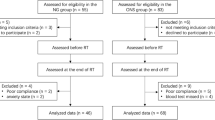Abstract
Purpose
To identify precipitating factors responsible for enteral nutrition (EN) dependency after concomitant chemoradiotherapy (CCRT) of head and neck cancers and to examine their statistical correlations.
Methods
Factors related to feeding condition, nutritional status, disease, and treatment of 26 oropharyngeal and hypopharyngeal cancer patients who received definitive CCRT were retrospectively investigated by examining their medical records. The days of no oral intake (NOI) during hospitalization and the months using enteral nutrition after CCRT were counted as representing the feeding condition, and the changes in body weight (BW) were examined as reflecting nutritional status. The factors related to EN dependency after CCRT were analyzed.
Results
Long duration of total NOI (≥ 30 days) and maximum NOI ≥ 14 days were significant predictors of EN dependency. Decreased BW (≥ 7.5 kg) was the next predictor identified, but it was not significant. Multivariate analysis showed that the total duration of NOI was more correlated with EN dependency than changes in BW.
Conclusions
A long duration of NOI was more strongly related to EN dependency than nutritional factors.


Similar content being viewed by others
References
Newman LA (1998) Eating and weight changes following chemoradiation therapy for advanced head and neck cancer. Arch Otolaryngol Head Neck Surg 124(5):589–592
Agarwal J, Shrivastava SK (2011) Objective assessment of swallowing function after definitive concurrent (chemo)radiotherapy in patients with head and neck cancer. Dysphagia 26(4):399–406
Shaw SM, Martino R (2015) The effect of prophylactic percutaneous endoscopic gastrostomy (PEG) tube placement on swallowing and swallow-related outcomes in patients undergoing radiotherapy for head and neck cancer: a systematic review. Dysphagia 30(2):152–175
Sadasivan A, Faizal B, Kumar M (2012) Nasogastric and percutaneous endoscopic gastrostomy tube use in advanced head and neck cancer patients: a comparative study. J Pain Palliat Care Pharmacother 26(3):226–232
Beaver ME (2001) Predictors of weight loss during radiation therapy. Otolaryngol Head Neck Surg 125(6):645–648
Orphanidou C (2011) Prophylactic feeding tubes for patients with locally advanced head-and-neck cancer undergoing combined chemotherapy and radiotherapy-systematic review and recommendations for clinical practice. Curr Oncol 18(4):e191-201
Madhoun MF (2011) Prophylactic PEG placement in head and neck cancer: how many feeding tubes are unused (and unnecessary)? World J Gastroenterol 17(8):1004–1008
National Cancer Institute. Common Terminology Criteria for Adverse Events version 3.0 and version 4.0 (CTCAE). National Cancer Institute Cancer Therapy Evaluation Program website. http://ctep.cancer.gov/protocolDevelopment/electronic_applications/ctc.htm
Jadad AR (1995) The WHO Analgesic Ladder for Cancer Pain Management. Stepping up the quality of its evaluation. JAMA 274(23):1870–1873
The NCCN. Clinical Practice Guidelines in Oncology (NCCN Guidelines®) Head and Neck Cancers version 2.2017. National Comprehensive Cancer Network website. https://www.nccn.org/professionals/physician_gls/pdf/head-and-neck.pdf
Evidence-based practice guidelines for the nutritional management of adult patients with head and neck cancer. Clinical Oncology Society of Australia website. http://wiki.cancer.org.au/australia/COSA:Head_and_neck_cancer_nutrition_guidelines
van der Linden NC (2017) Indicators for enteral nutrition use and prophylactic percutaneous endoscopic gastrostomy placement in patients with head and neck cancer undergoing chemoradiotherapy. Nutr Clin Pract 32(2):225–232
Yang W (2016) Predictive factors for prophylactic percutaneous endoscopic gastrostomy (PEG) tube placement and use in head and neck patients following intensity-modulated radiation therapy (IMRT) treatment: concordance, discrepancies, and the role of gabapentin. Dysphagia 31(2):206–213
Author information
Authors and Affiliations
Corresponding author
Ethics declarations
Conflict of interest
The authors declare that they have no conflict of interest.
Ethical approval
All procedures performed in studies involving human participants were in accordance with the ethical standards of the institutional and/or national research committee and with the 1964 Helsinki Declaration and its later amendments or comparable ethical standards. For this type of study, formal consent is not required.
Rights and permissions
About this article
Cite this article
Ishii, R., Kato, K., Ogawa, T. et al. Poor oral intake causes enteral nutrition dependency after concomitant chemoradiotherapy for pharyngeal cancers. Eur Arch Otorhinolaryngol 275, 1607–1611 (2018). https://doi.org/10.1007/s00405-018-4963-y
Received:
Accepted:
Published:
Issue Date:
DOI: https://doi.org/10.1007/s00405-018-4963-y




